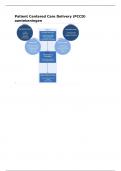Patient Centered Care Delivery (PCCD)
aantekeningen
,Theme 1: Introduction to PCCD and Patient centered
obesity care
The need for well-being management
Social production function theory (Lindenberg, 1996)
Increasing attention to the overall wellbeing (from physical effects to overall
(so also social)) of patients
High goal to achieve the overall well-being of patients. You need certain
aspects to address it.
Cronic illness --> not just the physical effects, but severe impact on social life
as well. Affection might be harder to reach (social well-being)
Main aim: both physical and social well-being is important to increase the
overall well-being of patients
Person/patient/user centered care all referred too, but is the same
Person-centered care = “providing care that is respectful of and responsive to
individual patient
preferences, needs, and values and ensuring that patient values guide all clinical
decisions." (IOM, 2001)
Organizing person-centered care is not easy
not just a talk with a patient, it is a lot more
Person-centered care, 8 dimensions:
1. Patient preferences
Should know what the preferences (goals etc.) of the patient are. Important because
it can be different for everyone. It should guide all decision making. Takes time,
need motivational/coaching skills when you talk about the patient needs. As a
patient it is also difficult to know what you want.
2. Information and education
Make sure the patient is in charge of their care. Professionals should provide
patients with that information. How can I get across the information in the right
way? Patient should also provide personal information to decide together with the
professional what is right for them.
3. Access to care
,Financial, don't wait too long to see a professional. Logical in NL because we have
healthcare insurance, but not in every country this is the case (for example the
U.S.). For example, can't afford the care.
4. Physical comfort
Physical effects of having a disease or illness. Should address it. Also in a literal
way, so provided by the healthcare organization (e.g. nice chairs)
5. Emotional support
Illness often accompanied by feelings of anxiety or depression. Physical discomfort
hand in hand with emotional side. Not easily done. Where to find it in the
community for example. Recognize that something is going on is very important
6. Family and friends
Illness impacts family and friends of the patients. How can I best support the
patient? Provide information to patient, but also the people around them (for
example having to cook with less salt)
7. Coordination of care
Within one healthcare organization. Information on changes within same
organization, for example changes in medication of the patient
8. Continuity and transition
When multiple healthcare organizations are involved. Also outside the organization:
for example physical therapist, a specialist, dietitian.
Need a certain level of all dimensions of care to become more person centered
(Rathert, 2012)
How is process related to outcomes. If you focus on the eight dimensions of person
centered care, it will lead to greater outcomes.
If you take your meds on time, then you can do this or that (so activation and
adherence will get higher), then it makes sense outcomes are better.
in this model, think of examples
Unpublished data:
Patient satisfaction greater satisfaction with care
Patient clinical outcomes greater social and physical well-being
Barriers to PCCD, three levels (in primary care):
(Kuipers, 2021)
, Patient Differences in patient needs and health literacy
o Every patient is different, different needs and differences in health
literacy skills. First figure out what the needs of the patient are. Not all
patients can be in charge (educational level, resources). This makes it
difficult for the professional to decide what is best for the patient to do.
Organization Differences in education, motivation and skills of healthcare
professionals/organizations
o Motivated as a whole to deliver person centered care (dimension 7 and
8).
o Skills are different, take that into account.
National Restrictive information sharing and a lack of supportive financial
structures
o The Netherlands: restrictive information sharing (continuity and
transition) because of privacy laws.
o Lack of supportive financial structures. Person centered care takes
more time which is not imbursed. Not stimulating right to take more
time for patients
PCC for patients living with obesity (application of the literature)
Why is it important to look at PCC for this patient group?
NL: half of NL population is overweight
Number of people has increased and
Chronic and relapsing disease (difficult to reverse)
Misconception of obesity
Underlying causes of obesity in adults (often misconceptions)
Some are rare (on the left), some are common
Lifestyle is influenced by many aspects. Accessible, affordable
Emphasize the complexity of obesity and focus on the individual differences.
Crompvoets et al. (2022)
There is no one-size-fits-all





